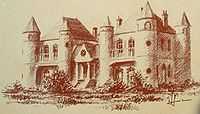Saint-Pol-Roux
| Paul-Pierre Roux | |
|---|---|
 | |
| Born |
15 January 1861 Marseille |
| Died |
18 October 1940 Brest |
| Pen name | Saint-Pol-Roux |
| Occupation | Poet and writer |
| Nationality | French |
| Period | 20th century |
| Genres | Poetry, opera, drama |
| Literary movement | Symbolism |
| Children | One daughter, Divine |
Paul-Pierre Roux, called Saint-Pol-Roux (15 January 1861, quartier de Saint-Henry, Marseille - 18 October 1940, Brest) was a French Symbolist poet.
Life
Marseille
Saint-Pol-Roux was born to a middle-class family in Marseille, where his father was an industrialist. He studied in a lycée in Lyon, but mysteriously ended his studies there. He then wrote some plays under his own name.
Years in Paris
He left the south of France to install himself in Paris. He particularly frequented the salon of Stéphane Mallarmé, for whom Saint-Pol-Roux had the greatest admiration. He won a certain notoriety, trying out several pseudonyms before finally becoming "Saint-Pol-Roux le magnifique". He even got one of his plays, La Dame à la faux, put on by Sarah Bernhardt, and was interviewed by Jules Huret as a member of the Symbolist movement. He perhaps participated in the Rosicrucian aesthetic of Péladan. Nevertheless, he wrote nothing on the movement or on its founder. Saint-Pol-Roux was doubtless interested in this audacious literary attempt, and had to leave it quickly.
Voluntary exile
Saint-Pol-Roux leaves Paris in 1898, having come to hate it for his being ostracized, and for the mediocrity of the literary criticism circles, ignoring it with as much pride as he himself had been ignored. On a clairvoyant's advice, and also to escape his creditors, he left, firstly for the Ardennes. There he settled with his wife in Roscanvel, in Finistère, where their daughter Divine was born. After his father's death, he moved to Camaret and made Britanny the center for his work.
Living off the revenue he earned from his libretto for the opera Louise, he bought a house overlooking the ocean, above the Pen Had beach, on the road to pointe de Pen Hir, and transformed it into a manor in the Baroque style. He named it the 'Manoir de Coecilian', after his son's name, or sometimes 'Manoir des Boultous'. He wrote "Facing the sea, man is closer to God" ("Face à la mer, l'homme est plus près de Dieu"). He welcomed several artists and writers, notably Louis-Ferdinand Céline, who looked up to him as an ancestor, and even Jean Moulin, then 'sous-préfet de Châteaulin', who visited in 1930.
Saint-Pol-Roux was a member of the académie Mallarmé from 1937 to 1940.
Death


During the night of 22 to 23 June 1940, a drunken German soldier invaded the manor, killed the family's faithful governess, raped Saint-Pol-Roux's daughter Divine, and seriously injured her in the leg with a revolver bullet. Saint-Pol-Roux miraculously escaped death in the incident, but was later taken to hospital in Brest on October 14, where he died of a broken heart when he heard that the manor had burned down with his unpublished manuscripts inside.
The following month, Louis Aragon published an article on the poet's "assassination," as he called it - "Saint-Pol Roux, ou L'Espoir" - in the journal Poésie. It was the first article published by Aragon after the fall of France, and was censored by the Vichy authorities.[1]
A forgotten poet
On the Liberation, Divine tried in vain to ensure that her father's work was not forgotten. It is in large part due to the salvage work, editing and publication of editions of his work by Rougerie during those years of, what she called, "purgatory" that his poems, essays and plays had escaped Nazi barbarism to be edited and re-edited anew. A considerable number of unedited manuscripts (Le Trésor de l'Homme, La Répoétique) survived the pillaging.
Saint-Pol-Roux is the archetypal "forgotten poet". It was under this title that he was a dedicatee of André Breton's Clair de Terre (also dedicated to "ceux qui comme lui s'offrent le magnifique plaisir de se faire oublier (sic)", or "those who like him offered themselves the great pleasure of making themselves forgotten"), and Vercors's Le Silence de la mer ( calling him "le poète assassiné", or "the assassinated poet").
Corpus
Saint-Pol-Roux attempted to create a total work of art. This dream of Symbolist literature consisted of creating a perfect work responding to all the senses. Saint-Pol-Roux himself was therefore very interested in plays and operas, during his Parisian years. At the end of his life, he filled himself with wonder at the artistic possibilities offered by the cinema.
Saint-Pol-Roux equally created the notion of "idéoréalisme". He desired an artistic fusion between the real world and the world of ideas, in a Neoplatonic perspective. He imagined a cosmology in which Beauty - lost in the real world - has to be revealed by the poet.
Works
- Under the name Paul Roux
- Maman!, Ollendorff, 1883
- Garçon d'honneur, Ollendorff, 1883
- Le Poète, Ghio, 1883
- Un drôle de mort, Ghio, 1884
- Rêve de duchesse, Ghio, 1884
- La Ferme, Ghio, 1886
- Under the name Saint-Pol-Roux
- Les Reposoirs de la procession, vol 1., Mercure de France, 1893
- L'Épilogue des saisons humaines, Mercure de France 1893
- La Dame à la faux, Mercure de France, 1899
- Les Reposoirs de la procession, vol. I : La Rose et les épines du chemin, Mercure de France, 1901
- Anciennetés, Mercure de France, 1903
- Les Reposoirs de la procession, vol. II : De la colombe au corbeau par le paon, Mercure de France, 1904
- Les Reposoirs de la procession, vol. III : Les Féeries intérieures, Mercure de France, 1907
- Les Fééries intérieures, 1907
- La Mort du Berger, Broulet, Brest, 1938, 69 p.
- La Supplique du Christ, 1939.
- Posthumously published
- Bretagne est Univers, Broulet, Brest, 1941
- Florilège Saint-Pol-Roux, L'Amitié par le Livre, 1943
- Anciennetés, Seuil, 1946
- L'Ancienne à la coiffe innombrable, Éd. du Fleuve, Nantes, 1946
- Août, Broder, 1958
- Saint-Pol-Roux "Les plus belles pages", Mercure de France, 1966
- Le Trésor de l'homme, Rougerie, Mortemart, 1970
- La Répoétique, Rougerie, Mortemart, 1971
- Cinéma vivant, , Rougerie, Mortemart, 1972
- Vitesse, Rougerie, Mortemart, 1973
- Les Traditions de l'avenir, Rougerie, Mortemart, 1974
- Saint-Pol-Roux / Victor Segalen, Correspondance, Rougerie, Mortemart, 1975
- La Transfiguration de la guerre, Rougerie, Mortemart, 1976
- Genèses, Rougerie, Mortemart, 1976
- La Randonnée, Rougerie, Mortemart, 1977
- De l'art magnifique, Rougerie, Mortemart, 1978
- La Dame à la faulx, Rougerie, Mortemart, 1979
- Les Reposoirs de la procession, vol. I : La Rose et les épines du chemin, Rougerie, Mortemart, 1980
- Les Reposoirs de la procession, vol. II : De la colombe au corbeau par le paon, Rougerie, Mortemart, 1980
- Les Reposoirs de la procession, vol. III : Les Féeries intérieures, Rougerie, Mortemart, 1981
- Le Tragique dans l'homme, vol. I : Les Personnages de l'individu, Les Saisons humaines, Tristan la Vie, Rougerie, Mortemart, 1983
- Le Tragique dans l'homme, vol. II : Monodrames, L'Âme noire du prieur blanc, Fumier, Rougerie, Mortemart, 1984
- Tablettes. 1885-1895, Rougerie, Mortemart, 1986
- Idéoréalités. 1895-1914, Rougerie, Mortemart, 1987
- Glorifications. 1914-1930, Rougerie, Mortemart, 1992
- Vendanges, Rougerie, Mortemart, 1993
- La Besace du solitaire, Rougerie, Mortemart, 2000 ISBN 2-85668-065-8
- Les Ombres tutélaires, Rougerie, Mortemart, 2005 ISBN 2-85668-112-3
Bibliography
- (French) Aragon, Louis (1945). Saint-Pol-Roux ou l'espoir. Brest: Seghers.
- (French) Bergot, Auguste (1947). Le Solitaire de Camaret. Brest: Poésia. p. 158.
- (French) Bergot, Auguste (1950). Épaves du Magnifique. Brest: Poésia. p. 96.
- (French) Briant, Théophile (1951). Saint-Pol-Roux. Paris.
- (French) Pelleau, Paul (1946). Saint-Pol-Roux, le crucifié. Paris: Éd. du fleuve. p. 206.
External links
References
- ↑ An English translation by Helen Burlin appears in Aragon: Poet of the French Resistance, editors Hannah Josephson and Malcolm Cowley, Duell, Sloane and Pearce, 1945
|